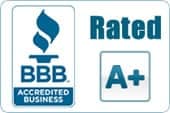The term “sewer drain” is often thought of to include any drainage pipe within a building. In actuality, it is the drain line that is used to carry drainage from other drain lines (often referred to as “secondary lines”) in your home, to the city sewer. It’s important to know this because sewer drain cleaning needs to be approached in a completely different way.
The Difference
When looking at the drain/waste/vent system for a typical home, you will see the all of the fixtures (except the toilet) drain into smaller drain lines (usually 1.5 – 2”). Those smaller lines (called “secondary lines”) all empty into a bigger (3-4”) main sewer line. That sewer drain line continues to carry the waste into the city main, where it is taken to the waste treatment facility.
The secondary lines may get clogged due to grease build up, hair clogs, lint, and all number of other things that are related to the fixtures they serve. Since the secondary lines are much smaller than the main, and they can run as far as 50’ or more before they hit the main, they are the ones that are affected by the buildup. The main stays pretty much unaffected, in most cases.
Yes, one may run across a sewer main in a residence that has some grease buildup in it, but in most cases, only very old ones that have been in service for a long time. Commercial mains may have more frequent grease buildup. The point is that while secondary lines can occasionally back up due to buildup of grease, or other debris, if a sewer main backs up, it is usually because there is a problem somewhere.
That is very important to consider when addressing a backup
How to Address the Backup
If you read our article on mainline backups, you will see that the most common cause for sewer backups is roots. That does not mean that that is your problem, but it is a good thing to keep in mind. Regardless of what it is, you should know that, conservatively speaking, at least 90% of all sewer drain cleaning is a temporary solution, aimed at restoring flow, with a bigger problem at its core.
Keeping this in mind, restoring flow is usually the first priority. That is accomplished by the appropriate use of access, equipment, and skill.
Access – To be an appropriate access point for restoring flow to a sewer line is one where the proper equipment can be used to access and clear the blockage, efficiently, and as thoroughly as possible. The best access point is always a full sized, sewer cleanout. A second option, though not even close to as good, is to remove a toilet, and run the machine through the “closet bend”.
Equipment – The proper equipment for clearing a sewer drain is either a full sized sewer cleaning machine with a full sized blade, or in some cases, a jetter. A full sized blade will not only do the best job of cleaning the line, but it will get caught on major offsets, breakages, and other problems that can be very serious, giving the plumber a heads up.
Skill – This is possibly the most underrated of the three… at least until the lack of skill creates a problem. It is a skilled professional’s job to not only find the best way to use the above two components, but to be able to read the situation. A skilled drain cleaner can feel what’s happening, and can gauge the feedback from his equipment. He knows when he hits a small blockage, or when he hits on offset. He knows when advanced tools like a sewer camera may be needed, and he knows what to do with the information he gets. A skilled plumber does not guess, he uses data points that he gathers throughout the process to give you the results that you want.
If you consider the fact that sewer drain cleaning starts as a symptomatic approach to a bigger problem, having someone do the work who is skilled at diagnosing the condition of the bigger problem is very important. See, it is much more than just poking a hole in a blockage with whatever machine is easiest for the person doing the work, as fast as possible.
In fact, more information on that topic can be found in our Clogged Drains article.
Don’t settle for less than a skilled professional. Call Allstar Plumbing!




